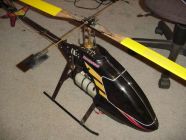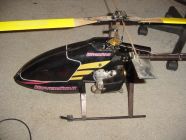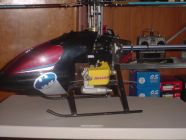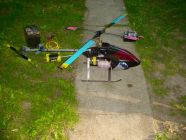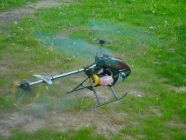Revolution Helicopters
Revolution HoverStar (199#)
A clone of the GMP Rebel with development by Len Sabato to update the flying characteristics and marketed by Horizon Hobbies. Changes seem to centre around revised paddles which are lighter, thinner and longer than the GMP originals. There was a revised canopy shape but basically it was a GMP Rebel in all but the name.
Following review from 1997 by Don Coe;
Product: HoverStar - Manufacturer: Revolution 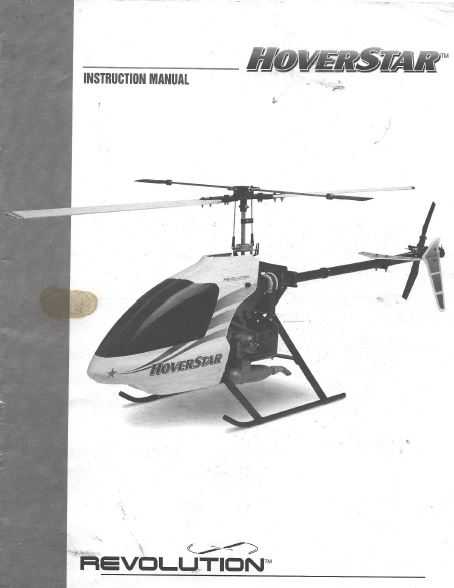
Rotor span: 42 inches. Length: 43 inches. Weight: 6.5 pounds. Required: .40 to .46 ball-bearing R/C aircraft engine and standard 4-channel aircraft radio (gyro recommended).
In the early 1970s, I was one of a small group of flyers trying to master helicopters with such models as the Schlüter Heli-Baby and the American R/C Revolution. I gave up, however, preferring the low maintenance and ease of flying fixed-wing aircraft. With the passage of 20 years, I became curious to discover whether changes in design and materials had made heli flight practical. The HoverStar was an appropriate choice, because it is designed specifically to help aircraft flyers make the transition to heli flight. The HoverStar utilizes a standard 4-channel aircraft radio and allows flyers simply to transfer their two-stroke, .40- to .46-size sport airplane engine and muffler.
What I discovered was that, despite glitches in assembly and flight testing, significant improvements have occurred. And, even though I needed expert advice to achieve success, the HoverStar is definitely appropriate for the modeller who enjoys a challenge. A video accompanying the kit provides important information on how to fly helicopters and additional details on building and setting up the model. Is it worth the extra effort? Absolutely! If you have been itching to try heli flight, but have not wanted to make the significant financial investment required, give the HoverStar a try.
The assembly
Assembly proceeded smoothly until I reached Section 4B (Swashplate Assembly). The swashplate is the mechanism that translates the fixed servo inputs to the turning rotor blades. It comprises a pair of machined plates connected by a ball-bearing race. It should rotate freely. Mine did not. Horizon Hobby Distributors sent me a replacement, which proved to be as balky as the first one. Horizon, which is the exclusive distributor of HoverStar, quickly traced the problem to a batch of improperly machined swashplate's supplied by a manufacturer.
Another snag came at Section 5 (Main Rotor Head Assembly). The fit between the main rotor head steel hub and the main rotor head body should be snug, but allow free pivoting. I had to file the hub to obtain a proper fit. Later, while mindlessly tightening the clamps on the Tail Boom Attachment, I managed to over-torque and break two of them. Horizon sent me replacement parts immediately.
Initial setup and flight testing
I outfitted the HoverStar with a Futaba Skysport 6VA radio, FP-G153 gyro and an OS .46 SF ABC engine. Initial runup looked favourable (I used 10 percent nitro fuel). Blade tracking needed no adjustment and vibrations were within tolerance. I adjusted tail-rotor pitch after my first attempts at hover. Next, however, I experienced engine overheating problems. Apparently, the OS .46 engine is slightly taller than the recommended engines -- ASP .46 FSR and Thunder Tiger Pro .46 -- causing problems with the cooling fan shroud. I ordered a new engine shroud from Horizon and, just to be on the safe side, bought 15 percent nitro heli fuel for the next flight trials. Unfortunately, with 90-plus-degree weather, I could only sustain a hover for a few seconds before the engine overheated and sagged.
Placing a second call to Horizon, I spoke with Len Sabato, one of the HoverStar's key designers. Len was most helpful. He explained that in my attempt to trim the engine shroud to clear the top of the head, critical cooling air was not being directed across the top of the head. Additionally, Len was concerned about the OS engine being intolerant to the heat transients of heli flight. He also offered insights about the drive belt being too tight and possibly contributing to engine overheating.
When a new engine fan shroud arrived, I installed it. My next trip to the flying field coincided with a visit by a heli-flying friend and master machinist, who felt the drive belt still was too tight. He also recommended relaxing the fit between the main and intermediate bevel gears. The result? We were able to accomplish semi-sustained hover. However, engine overheating still posed a problem, so we adjusted the clutch shaft and the engine high and low end. We also switched to 15 percent standard nitro aircraft fuel; success, at last!
The engine ran reliably for the entire tank, and we achieved several sustained hovers. After some 20 years away from helicopters, I was amazed at how easy it was to fly the HoverStar. The controls were smooth and very responsive. What a feeling! I was in control of the aircraft and able to complete simple hover manoeuvres easily.

